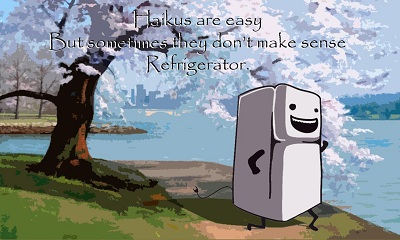
Haiku (originally Hokku) is a form of Japanese poetry consisting of 17 moras in three phrases of five, seven and five moras respectively. Moras differ from syllables in a variety of ways. One mora in Japanese can be equal to one short syllable, one elongated vowel, dipthong, doubled consonant, or one “n” at the end of a syllable. The word “haibun” contains two syllables (hai-bun) but four moras (ha-i-bu-n). “Tokyo” contains three syllables (To-ky-o) but four moras in Japanese (To-u-kyo-u).
American forms of haiku are a more relaxed form of the poetry. Take, for example, my favorite haiku written by Jack Kerouac: snap your finger / stop the world / rain falls harder. As you can see, the first line contains only four syllables, the second contains three and the third line contains four. According to the Haiku Society of America, the norm for American haiku is to use seventeen syllables. The past president of the HSA, Alexis Rotella, could not resist one of these shorter haikus in the Summer 2009 print of “Prune Juice – Journal of Senryu and Kyoka”:
She could use
a good editor –
chatterbox
As you can see, American haiku is not strictly limited to seventeen syllable poems about nature. Haiku can be about anything, everything or nothing. It can be short (less than seventeen syllables) or traditional. You may use capitalization, but it is not required except when referring to a proper noun. It may or may not rhyme. The only requirements for an American haiku are three lines and a topic.
Haiku is easy to write, but difficult to write well. The secret to writing beautiful haiku is to make your phrases memorable. It must create an image so unique that it burns an image into the mind of the reader. If you think about the structure of a haiku poem, you know the first and second lines tend to draw a rather ordinary picture. In Jack Kerouac’s haiku, you see in the first two lines an image of someone snapping their fingers and stopping time. Though it creates a wonderful idea in the reader’s mind, “if only I could stop time that easily…”, it is not enough. It is dull. It is the third line that makes the poem unique and memorable; “rain falls harder” indicates that the world has stopped for just a moment, just long enough for the raindrops to pause in midair and for the reader to “witness” these events. Then it is over. Time returns to normal and the rain falls to the ground. However, there was that one moment of magic – that moment when the earth stood still – that made the poem beautiful.
Another method of creating memorable haiku is the “unfinished” poem. Though the haiku consists of three lines and completes an idea, there are still a few questions left unanswered. In Denis M. Garrison’s book of haiku entitled “Hidden River”, there is one such poem on page 46:
The old tomcat hunting
at meadow’s edge
he waits …
The reader asks, “he waits… and then what happens?” This is what makes the haiku memorable. The first line presents us with a tomcat, hunting. For what, we don’t know. The second line indicates that the tomcat is hunting for something in a meadow; this immediately creates an image of the cat being hidden by green grass. This cat is an unstoppable predator… he is unseen and he is about to pounce. What is stopping him from pouncing? He is waiting for the right moment: the moment when he can jump at his prey and sink his teeth into the fresh kill. What we don’t know is what happens when he attacks. Does he catch his prey? Does the victim escape? We will never know, and this sort of mystery expands the poem. It makes us think beyond the writing
Editor’s Note: Readers are urged to send their original Haiku to 100Feed via comments on this post. Once we collect 100 original haikus, we will publish them in one of our 100Feed lists of haiku. The poem can be about anything and you may write them in either Japanese form or in the American form. Be sure to include your first and last name in the comment.
Tags: haiku, poetry, writing


